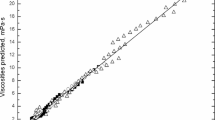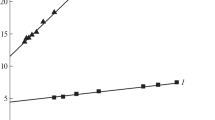Abstract
The discrepancy of the existing literature data on the surface tension values of biopolymer solutions could be affected by the measurement technique. The aim of the study was to compare the surface tension values of biopolymer solutions, measured using the du Nouy ring method and the drop weight methods (Harkins–Brown correction factors method and the LCP coefficient method). Four biopolymers were chosen (sodium alginate, carboxymethyl cellulose, xanthan gum and pectin) and the surface tensions of the solutions were measured as a function of biopolymer concentration. The surface tension was found to increase with biopolymer concentration when measured using the du Nouy ring method. On the other hand, the drop weight methods gave an opposite trend. The results verified the discrepancy of the existing literature data. The error may be caused by the correction factors calculation and the solution viscosity when the du Nouy ring method was used. The LCP coefficient method which is independent of correction factors and liquid properties is proposed for measurement of the surface tension of viscous biopolymer solutions.






Similar content being viewed by others
Abbreviations
- Ψ :
-
Correction factor of ring method
- ρ :
-
Density (g/ml)
- Ψ(r/V 1/3 ) :
-
Drop weight correction factor in function of (r/V 1/3)
- G :
-
Gravitational force (981 cm/s2)
- C 2 :
-
Linear coefficients of quadratic equation between drop weight and dripping tip radius
- m :
-
Mass of falling drop (g)
- F max :
-
Maximum pull force (N)
- r :
-
Radius of dripping tip (cm)
- R′ :
-
Radius of du Nouy ring wire (cm)
- R :
-
Radius of du Nouy ring (cm)
- γ :
-
Surface tension (mN/m)
- V :
-
Volume of a detached drop (cm3)
References
Born K, Langendorft V, Boulenguer P (2002) Chapter 11 Xanthan. In: Vandomme EJ, De Baets S, Steinbuchel A (eds) Biopolymers, vol 5., Biology chemistry biotechnology application, polysaccharides i polysaccharides from prokaryotesWiley, Weinheim, pp 259–297
Shilpa A, Agrawal SS, Ray AR (2003) Controlled delivery of drugs from alginate matrix. J Macromol Sci C 43:187–221
Mammarella EJ, Rubiolo AC (2003) Cross linking kinetics of cation-hydrocolloid gels. Chem Eng J 94:73–77
Yang Z, Fan X, Bakalis S, Parker DJ, Fryer PJ (2008) Impact of solids fraction and fluid viscosity on solids flow in rotating cans. Food Res Int 41:658–666
Hershko V, Nussinovitch A (1998) The behavior of hydrocolloid coatings on vegetative materials. Biotechnol Prog 14:756–765
Watanabe H, Matsuyama T, Yamamoto H (2003) Experimental study on electrostatic atomization of highly viscous liquids. J Electrostat 57:183–197
Zohar-Perez C, Chet I, Nussinovitch A (2004) Irregular textural features of dried alginate-filler beads. Food Hydrocolloid 18:249–258
Del Gaudio P, Colombo P, Colombo G, Russo P, Sonvico F (2005) Mechanisms of formation and disintegration of alginate beads obtained by prilling. Int J Pharm 302:1–9
Brandenberger H, Widmer F (1998) A new multinozzle encapsulation immobilisation system to produce uniform beads of alginate. J Biotechnol 63:73–80
Chan ES, Lee BB, Ravindra P, Poncelet D (2009) Prediction models for shape and size of ca-alginate macrobeads produced through extrusion–dripping method. J Colloid Interface Sci 338:63–72
Eren H (1999) Chapter 21. Density measurement. In: Webster JG (ed) Measurement, instrumentation and sensors handbook. CRC Press, Boca Raton, pp 21-1–21-16
Lee BB, Ravindra P, Chan ES (2009) New drop weight analysis for surface tension determination of liquids. Colloid Surf A 332:112–120
Seifert DB, Philips JA (1997) Production of small, monodispersed alginate beads for cell immobilization. Biotechnol Prog 13:562–568
Al-Hajry HA, Al-Maskry SA, Al-Kharousi LA, El-Mardi O, Shayya WH, Goosen MFA (1999) Electrostatic encapsulation and growth of plant cell cultures in alginate. Biotechnol Prog 15:768–774
Rousseau I, Le Cerf D, Picton L, Argillier JF, Muller G (2004) Entrapment and release of sodium polystyrene sulfonate (SPS) from calcium alginate gel beads. Eur Polym J 40:2709–2715
Herrero EP, Del Valle EMM, Galan MA (2006) Development of a new technology for the production of microcapsules based in atomization processes. Chem Eng J 117:137–142
Fundueanu G, Esposito E, Mihai D, Carpov A, Desbrieres J, Rinaudo M, Nastruzzi C (1998) Preparation and characterization of Ca-alginate microspheres by a new emulsification method. Int J Pharm 170:11–21
Simcone M, Alfani A, Guido S (2004) Phase diagram, rheology and interfacial tension of aqueous mixtures of Na-caseinate and Na-alginate. Food Hydrocolloid 18:463–470
Day DF (1998) Chapter 5, Alginates. In: Kaplan DL (ed) Biopolymers from renewable resources. Springer, Berlin, pp 119–143
Sabra W, Deckwer W (1998) Alginate—a polysaccharide of industrial interest and diverse biological functions. In: Dumitriu S (ed) Polysaccharides. Structural diversity and functional versatility. Markel Dekkar, Inc., New York, pp 515–531
Marcotte M, Hoshahili ART, Ramaswamy HS (2001) Rheological properties of selected hydrocolloids as a function of concentration and temperature. Food Res Int 34:695–703
Thiessen DB, Man KF (1999) Surface tension measurement, In: Measurement, instrumentation and sensors handbook. CRC Press LLC, Boca Raton, pp 31-1–31-13
Babak VG, Skotnikova EA, Lukina LG, Pelletier S, Hubert P, Dellacherie E (2000) Hydrophobically associating alginate derivatives: surface tension properties of their mixed aqueous solutions with oppositely charged surfactants. J Colloid Interface Sci 225:505–510
Zuidema HH, Waters GW (1941) Ring method for the determination of interfacial tension. Ind Eng Chem Anal Ed 13:312–313
Harkins WD, Brown FE (1919) The determination of surface tension (free surface energy), and the weight of falling drops: the surface tension of water and benzene by the capillary height method. J Am Chem Soc 41:499–524
Lee BB, Ravindra P, Chan ES (2008) A critical review: surface and interfacial tension measurement using the drop weight method. Chem Eng Commun 195:889–924
Kawanishi T, Seimiya T, Sasaki T (1970) Correction for surface tension measured by Wilhelmy method. J Colloid Interface Sci 32:622–627
Van Santvliet L, Ludwig A (1999) Influence of the physico-chemical properties of ophthalmic viscolysers on the weight of drops dispensed from a flexible dropper bottle. Eur J Pharma Sci 7:339–345
Drelich J, Fang CH, White CL (2002) Measurement of interfacial tension in fluid–fluid systems. In: Hubbard AT (ed) Encyclopedia of surface and colloid science. Marcel Dekkar Inc, New York, pp 3152–3166
Halard B, Kawase Y, Moo-Young M (1989) Mass transfer in a pilot plant scale airlift column with non-Newtonian fluids. Ind Eng Chem Res 28:243–245
Weber FE, Taillie SA, Stauffer KR (1974) Functional characteristics of mustard mucilage. J Food Sci 39:461–466
Tomanova V, Pielichowski K, Srokova I, Zoldakova A, Sasinkova V, Ebringerova A (2008) Microwave-assisted synthesis of carboxymethylcellulose-based polymeric surfactants. Polym Bull 60:15–25
Jomsurang P, Sakamon D (2005) Evaluation of the effects of some additives and pH on surface tension of aqueous solutions using a drop-weight method. J Food Eng 70:219–226
Cao Y, Li H (2002) Interfacial activity of a novel family of polymeric surfactants. Eur Polym J 38:1457–1463
Guillot S, Delsanti M, Desert S, Langevin D (2003) Surfactant-induced collapse of polymer chains and monodisperse growth of aggregates near the precipitation boundary in carboxymethylcellulose–DTAB aqueous solutions. Langmuir 19:230–237
Garti N, Madar Z, Aserin A, Sternheim B (1997) Fenugreek galactomannans as food emulsifiers. Lebensm Wiss Technol 30:305–311
Huang X, Kakuda Y, Cui W (2001) Hydrocolloids in emulsions: particle size distribution and interfacial activity. Food Hydrocolloid 15:533–542
Huh C, Mason SG (1975) A rigorous theory of ring tensiometry. Colloid Polym Sci 253:566–580
Freud BB, Freud HZ (1930) A theory of the ring method for the determination of surface tension. J Am Chem Soc 52:1772–1782
Harkins WD, Jordan HF (1930) A method for the determination of surface and interfacial tension from the maximum pull on a ring. J Am Chem Soc 52:1751–1772
Paddy JF, Russell DR (1960) The measurement of the surface tension of pure liquids and solutions. J Colloid Interface Sci 15:503–511
Drost-Hansen W (1965) Precise measurements of surface & interfacial tension can provide clues to liquid structure. Ind Eng Chem 57:38–44
Lunkenheimer K, Wantke KD (1981) Determination of the surface tension of surfactant solutions applying the method of Lecomte du Nouy (ring tensiometer). Colloid Polym Sci 259:354–366
Morrison ID, Ross S (2002) Colloidal dispersions. Suspensions, emulsions and foams. Wiley, New York, pp 246–260
Hauser EA, Edgerton HE, Holt BM, Cox JT Jr (1936) The application of the high-speed motion picture camera to research on the surface tension of liquids. J Phys Chem 40:973–988
Lapham GS, Dowling DR, Schultz WW (1999) In situ force-balance tensiometry. Exp Fluids 27:157–166
Docoslis A, Giese RF, Van Oss CJ (2000) Influence of the water-air interface on the apparent surface tension of aqueous solutions of hydrophilic solutes. Colloid Surf B 19:147–162
Hunter RJ (2001) Foundations of colloid science, 2nd edn. Oxford University Press Inc, New York, pp 435–459
Acknowledgments
The authors thank the Faculty of Pharmacy, International Islamic University Malaysia (Kuantan, Malaysia) for providing the facility to use the du Nouy ring tensiometer.
Author information
Authors and Affiliations
Corresponding author
Rights and permissions
About this article
Cite this article
Lee, BB., Chan, ES., Ravindra, P. et al. Surface tension of viscous biopolymer solutions measured using the du Nouy ring method and the drop weight methods. Polym. Bull. 69, 471–489 (2012). https://doi.org/10.1007/s00289-012-0782-2
Received:
Accepted:
Published:
Issue Date:
DOI: https://doi.org/10.1007/s00289-012-0782-2




